[press release]
Royal Mail Issues New Stamps on the 250th Anniversary of the Birth Of William Wordsworth
- Wordsworth is regarded as having been at the forefront of the Romantic movement of British poetry
- The stamps also celebrate other notable Romantic poets from the period: William Blake; John Keats; Lord Byron; Samuel Taylor Coleridge; Mary Robinson; Percy Bysshe Shelley; Walter Scott; John Clare; and Letitia Elizabeth Landon
- Each stamp uses an extract from one of their most popular and enduring works, along with a specially-commissioned illustration by the artist, Linda Farquharson
- Royal Mail worked with the award-winning biographer, Jonathan Bate on the stamp; issue
- A full set of all 10 stamps, available in a Presentation Pack, retails at £8.50
- The stamps and a range of collectible products are available now at www.royalmail.com/romanticpoets and by phone on 03457 641 641
- The stamps will be available on general sale from today (7 April)
 Royal Mail has announced the launch of 10 new Special Stamps on the 250th anniversary of the birth of William Wordsworth, the renowned Romantic poet, born on 7th April 1770.
Royal Mail has announced the launch of 10 new Special Stamps on the 250th anniversary of the birth of William Wordsworth, the renowned Romantic poet, born on 7th April 1770.
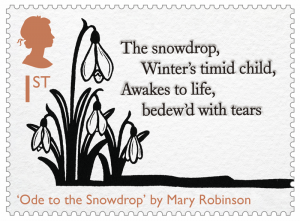 The stamps also celebrate other major Romantic poets: William Blake; John Keats; Lord Byron; Samuel Taylor Coleridge; Mary Robinson; Percy Bysshe Shelley; Walter Scott; John Clare; and Letitia Elizabeth Landon.
The stamps also celebrate other major Romantic poets: William Blake; John Keats; Lord Byron; Samuel Taylor Coleridge; Mary Robinson; Percy Bysshe Shelley; Walter Scott; John Clare; and Letitia Elizabeth Landon.
Each stamp uses an extract from one of their most popular and enduring works, along with a specially-commissioned, monochrome design that reflects the theme of the poem.
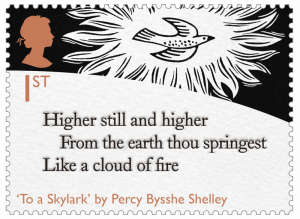 The Romantic poets made poetry more passionate and more personal than ever before, and they embraced romantic landscapes and the natural world with vigour. Some became international household names. Lord Byron (1788–1824) was the original celebrity author and Sir Walter Scott (1771–1832) became famous as the inventor of the historical novel. By contrast, the genius of some others, notably William Blake (1757–1827) and John Clare (1793– 1864), was recognised only after their deaths.
The Romantic poets made poetry more passionate and more personal than ever before, and they embraced romantic landscapes and the natural world with vigour. Some became international household names. Lord Byron (1788–1824) was the original celebrity author and Sir Walter Scott (1771–1832) became famous as the inventor of the historical novel. By contrast, the genius of some others, notably William Blake (1757–1827) and John Clare (1793– 1864), was recognised only after their deaths.
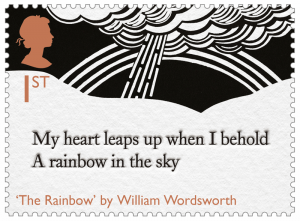 The poet who came to be seen as the primary voice of the Romantic movement, was William Wordsworth (1770–1850). Wordsworth’s early work was initially neglected. Lyrical Ballads (written with his friend and contemporary, Samuel Taylor Coleridge) and published anonymously, was often derided, but leading Victorian thinkers would come to regard him as the greatest English poet since Shakespeare.
The poet who came to be seen as the primary voice of the Romantic movement, was William Wordsworth (1770–1850). Wordsworth’s early work was initially neglected. Lyrical Ballads (written with his friend and contemporary, Samuel Taylor Coleridge) and published anonymously, was often derided, but leading Victorian thinkers would come to regard him as the greatest English poet since Shakespeare.
In 1843, Queen Victoria made Wordsworth her Poet Laureate. 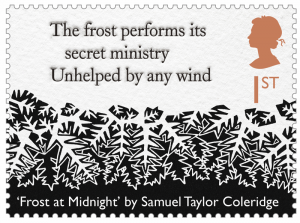 When he died seven years later, his influence was immense, and his poetry genuinely changed the world.
When he died seven years later, his influence was immense, and his poetry genuinely changed the world.
Coleridge (1772– 1834) wrote some of his best work around the turn of the century – penning the mysterious ‘Kubla Khan’ as well as his beautiful poem ‘Frost at Midnight’, addressed to his sleeping baby son Hartley.
An admired female poet of the era was Mary Robinson (1757–1800) [stamp illustrated above]. In her mid-twenties, Mary was crippled by rheumatic fever and lost the use of her legs. She remade herself as a bestselling novelist, an author of a book arguing for women’s rights and a prolific lyric poet.
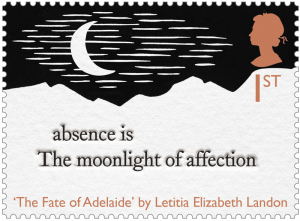 Many other women poets were celebrated during this period, including Letitia Elizabeth Landon (1802–38), who published under the initials LEL, and became known as ‘the female Byron’. Her life was beset by scandal, but her poetry – most of it published in the early 19th-century – was greatly admired for its intelligence and imagination.
Many other women poets were celebrated during this period, including Letitia Elizabeth Landon (1802–38), who published under the initials LEL, and became known as ‘the female Byron’. Her life was beset by scandal, but her poetry – most of it published in the early 19th-century – was greatly admired for its intelligence and imagination.
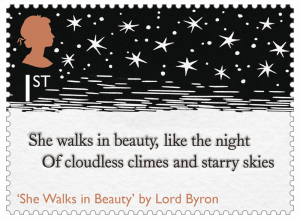 Technically, Lord Byron was a master of every poetic form, as adept in satire and wit as in the lyric of love or the evocation of Mediterranean landscapes. In exile on the Continent following a scandalous divorce, he befriended Percy Bysshe Shelley (1792–1822) [stamp design above]. Shelley was both a romantic idealist and a political radical: he was at his best in his glorious odes addressed to the skylark and to the west wind. He died, tragically, just before his 30th birthday, when out sailing in a storm off the Italian coast.
Technically, Lord Byron was a master of every poetic form, as adept in satire and wit as in the lyric of love or the evocation of Mediterranean landscapes. In exile on the Continent following a scandalous divorce, he befriended Percy Bysshe Shelley (1792–1822) [stamp design above]. Shelley was both a romantic idealist and a political radical: he was at his best in his glorious odes addressed to the skylark and to the west wind. He died, tragically, just before his 30th birthday, when out sailing in a storm off the Italian coast.
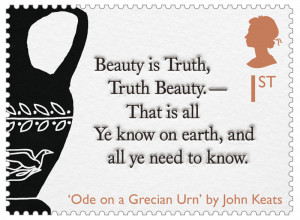 Another early death was that of John Keats (1795–1821), who succumbed to tuberculosis in Rome, aged just 25. Keats was the epitome of the Romantic poet: impoverished but idealistic, full of vitality in everything he wrote but always conscious of mortality. As with Shelley, his most anthologised poems are his odes, lyrical works addressed to a particular subject – in Keats’s case, a nightingale or the season of autumn or a beautiful urn that has survived since ancient Greece, with its depictions of sensuous scenes and its message that truth is beauty and beauty truth.
Another early death was that of John Keats (1795–1821), who succumbed to tuberculosis in Rome, aged just 25. Keats was the epitome of the Romantic poet: impoverished but idealistic, full of vitality in everything he wrote but always conscious of mortality. As with Shelley, his most anthologised poems are his odes, lyrical works addressed to a particular subject – in Keats’s case, a nightingale or the season of autumn or a beautiful urn that has survived since ancient Greece, with its depictions of sensuous scenes and its message that truth is beauty and beauty truth.
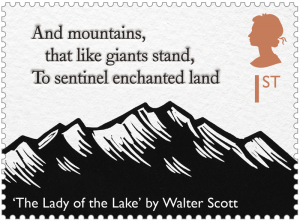 Some of the Romantics were highly respectable figures, such as Sir Walter Scott, whose poem, The Lady of the Lake,inspired generations of tourists to visit the Scottish Highlands; others were marginal, isolated figures. William Blake [stamp design below] published his own works in tiny, illustrated, hand-engraved editions. Though his ‘Jerusalem’ is now known by everyone, and his Songs of Innocence and of Experience are much loved, not many read his poems while he was
Some of the Romantics were highly respectable figures, such as Sir Walter Scott, whose poem, The Lady of the Lake,inspired generations of tourists to visit the Scottish Highlands; others were marginal, isolated figures. William Blake [stamp design below] published his own works in tiny, illustrated, hand-engraved editions. Though his ‘Jerusalem’ is now known by everyone, and his Songs of Innocence and of Experience are much loved, not many read his poems while he was 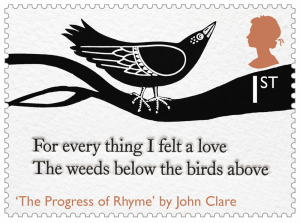 alive. John Clare, meanwhile, achieved brief fame as ‘the Northamptonshire Peasant Poet’ – he suffered from poverty, neglect and mental illness, spending the last 25 years of his life in a lunatic asylum.
alive. John Clare, meanwhile, achieved brief fame as ‘the Northamptonshire Peasant Poet’ – he suffered from poverty, neglect and mental illness, spending the last 25 years of his life in a lunatic asylum.
Royal Mail spokesperson Philip Parker said: “The Romantic poets composed some of the most loved poetry of all time, and our striking new stamps celebrate the genius of their imaginations.”
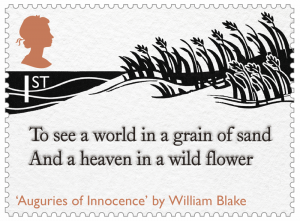 Royal Mail worked with the award-winning biographer, Jonathan Bate, on the stamp issue. The images are lino-cut illustrations by the artist, Linda Farquharson.
Royal Mail worked with the award-winning biographer, Jonathan Bate, on the stamp issue. The images are lino-cut illustrations by the artist, Linda Farquharson.
The full range of stamps, and other collectible products are available now at www.royalmail.com/romanticpoets and by phone on 03457 641 641.
The full set of 10 stamps, available in a Presentation Pack, retails at £8.50.



